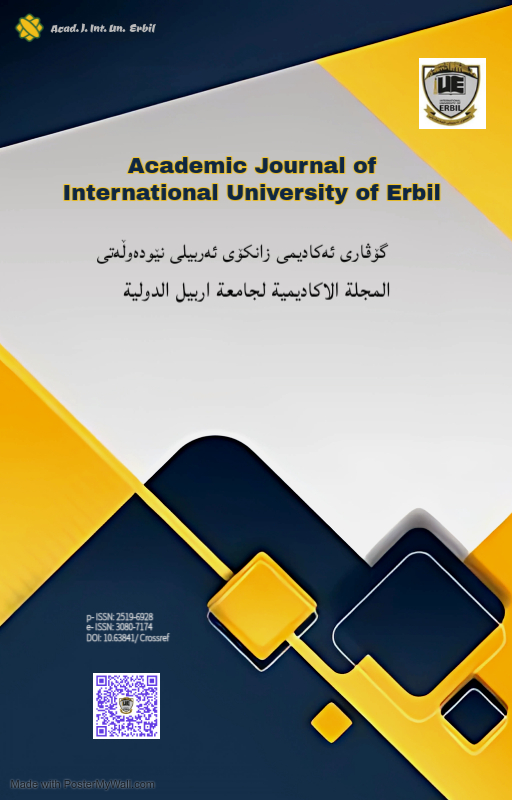Reimagining Content Marketing in Emerging Markets: The Shift from Blogging to Interactive Media in Erbil, Iraq
Reimagining Content Marketing in Emerging Markets
DOI:
https://doi.org/10.63841/iue23514Keywords:
Content Marketing Evolution, Blogging and Interactive Media, Video Content Strategies, Data Analytics in Marketing, Audience Engagement Techniques.Abstract
ABSTRACT:
This study explores the evolution of content marketing, focusing on the transition from traditional blogging to interactive media, with an emphasis on marketing professionals in Erbil, Iraq. The research addresses the challenges businesses face in adapting to rapidly changing consumer preferences and technological advancements. Utilizing a researcher-developed questionnaire, data were collected from 150 marketing professionals to evaluate perceptions of content marketing strategies, including the roles of blogging, video content, data analytics, and thought leadership. Findings reveal that key elements such as video content and data analytics significantly influence favorable attitudes toward modern content marketing strategies. Ordinal logistic regression analysis highlights the importance of integrating traditional and innovative approaches to enhance audience engagement. The study emphasizes the need for personalization and the use of interactive technologies in emerging markets. This research contributes practical recommendations for marketers, emphasizing the balance between legacy content strategies and immersive media to adapt effectively in a competitive digital landscape.
References
J. Pulizzi, “The rise of storytelling as the new marketing,”. Publishing Research Quarterly, vol.28, no.2, pp.116-123, 2012
J. Rowley, “Understanding digital content marketing,” Journal of Marketing Management, vol. 24 no. 5,6, pp.517-540, 2008.
A. M. Kaplan, & M. Haenlein, “Users of the world, unite! The challenges and opportunities of social media,” Business Horizons, vol. 53, no.1, pp.59-68, 2010.
W.G. Mangold, & D. J. Faulds, “Social media: The new hybrid element of the promotion mix,” Business Horizons, vol. 52, no. 4, pp.357-365, 2009.
L. De Vries, S. Gensler, & P. S. Leeflang, “Popularity of brand posts on brand fan pages: An investigation of the effects of social media marketing,” Journal of Interactive Marketing, vol. 26, no. 2, pp.83-91, 2012.
L. Hollebeek, & K. Macky, “Digital content marketing's role in fostering consumer engagement, trust, and value: Framework, fundamental propositions, and implications,” Journal of Interactive Marketing, vol. 45, pp.27-41, 2019.
D. M. Scott, “The new rules of marketing and PR,” John Wiley & Sons, 2015.
J. J. Sierra, “Augmented reality and virtual reality in marketing: A review and research agenda,” Journal of Business Research, vol. 119, pp.262-271, 2020.
M. Wedel, & P. K. Kannan, “Marketing analytics for data-rich environments,” Journal of Marketing, vol. 80, no. 6, pp.97-121, 2016.
K. Y. Tam, & S. Y. Ho, “Understanding the impact of web personalization on user information processing and decision outcomes,” MIS Quarterly, vol. 30, no. 4, pp.865-890, 2006.
E. Katz, J. G. Blumler, & M. Gurevitch, “Uses and gratifications research,” The Public Opinion Quarterly, vol. 37, no. 4, pp.509-523, 1974.
F. D. Davis, “Perceived usefulness, perceived ease of use, and user acceptance of information technology,” MIS Quarterly, vol. 13, no. 3, pp. 319-340, 1989.
D. Lee, K. Hosanagar, & H. S. Nair, “Advertising content and consumer engagement on social media: Evidence from Facebook,” Management Science, vol. 64, no. 11, pp.5105-5131, 2018.
Y. Wang, & Y. Kim, “The impact of social media on value co-creation and customer retention,” Journal of Retailing and Consumer Services, vol. 40, pp.153-163, 2017.
Downloads
Published
Issue
Section
License
Copyright (c) 2025 Academic Journal of International University of Erbil

This work is licensed under a Creative Commons Attribution-NonCommercial-NoDerivatives 4.0 International License.












